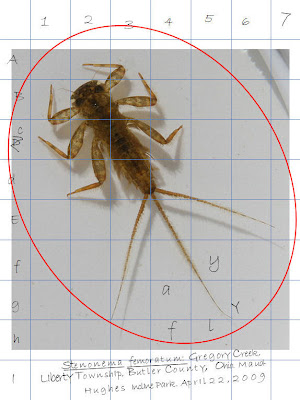
This is a Stenonema femoratum mayfly nymph, sometimes called a "Cream Cahill." Mayfly taxonomy has changed dramatically over the years, and unfortunately, the best sources for field or microscope ID available to the non-specialist are out of date. To make the sources sync with today's taxonomy requires various translation sheets. It gets rather confusing. Across the mayflies of North America are many genera and species that have been lumped or reassigned, in many cases to the consternation of anglers who point out that some lumped species contain two or more forms that have different hatch periods as well as different and distinctive body markings. Genetic work has had a huge impact on mayfly taxonomy and from what I've read, or at least from what I understand, the majority of the taxonomy changes have resulted from laboratory work.
Maybe a better explanation for some of the problems taxonomic changes have caused fly fisherman and interested non-specialists would be to consider how birders would respond if the Dendroica genus were to be rearranged such that there were only five or so "good" species, containing assorted lumps of species with distinctly different songs, plumages and even ranges. Blackpoll and Bay-breasted? A single species. Black-throated Green, Townsend's, Hermit, Golden-cheeked (toss in Black-throated Gray, too). One species. And then for a topper, Black-and-White Warbler would be moved to Dendroica, but since its genus, Mniotilta, was described before Dendroica, under the taxonomic rules, Dendroica would disappear and everything remaining in that genus would be called Mniotilta. In a word, we birders would go cuckoo.
The "Troutnut.com" site has a brief explanation of the rather dramatic changes to the once mighty Stenonema genus, which used to contain a host of field identifiable species, but now contains a single species, femoratum, which is a lumping of at least two forms that many fisherman and even some scientists agree are field-identifiable critters.
Stenonema femoratum is a member of the family Heptageniidae, and like the other members in that family, the nymphs have distinctly flattened bodies, and are usually found clinging to the undersides of stones and debris in shallow, fast-flowing areas of streams and rivers. S. femoratum is a very common species in these parts. The specimen in the piece above is about 1 cm in length, not including the tails. The two cream-colored "x"-looking marks toward the end of the abdomen (grid "D3") are distinctive in this species, as are two rows of usually three or more black dots at the tip of the underside of the abdomen. One can usually identify this species in the field. Find a local stream, pick up a few rocks in a section of shallow riffles, and soon enough, you should find S. femoratum. If you don't find any, the stream you're crawling around in might not be the healthiest place you could choose to do your wading.
Comments
Post a Comment